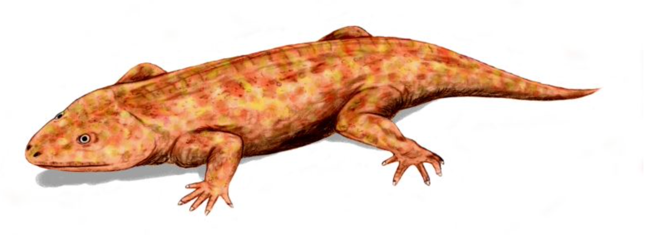
General Information
Seymouria is an extinct animal of the genus Reptiliomorpha, which inhabited the United States and Germany about 280 million years ago: thus, Seymouria was among the first four-legged animals to live on land. As is clear, the animal’s existence occurred during the dry Permian period, so adaptation to a terrestrial environment was necessary for successful survival. Adaptation to the terrestrial way of life in the quadruped was realized through dry, keratinous skin, the functional ability to retain fluids in the body for a long time, and long, powerful paws. Life away from water bodies changed the amphibian’s diet: Seymouria mainly fed small reptiles and insects. At the same time, the offspring were incubated in bodies of water where females came after mating with males: for this reason, Seymouria larvae had external gill slits.
Skull structure
When analyzing the cranial structure of Seymouria, many analogies with amphibians, true reptiles, and early tetrapods are found. In particular, the lower jaw of the ancient animal is movable and has an opening located in the inner partition. The upper jaw of Seymouria was covered with massive fangs and teeth, and they were located not only along the edge of the jaw but also on the palate. The teeth had a labyrinthodont configuration, which among others, defines Seymouria as an early tetrapod. In addition, the skull of the animal had a flat structure, and a small opening for the pineal gland was found on its upper part, as is true for mammals. It is interesting that the bones of the skull of the male animal were, on average, thicker and more robust than those of the females. This becomes evidence of a possible mechanism of a struggle between males for resources and mating.
Structure of the postcranial skeleton
Adaptation to a terrestrial lifestyle had the most significant effect on the structure of the spine and limb-girdle of the extinct animal. The length of the animal did not exceed 60 centimeters, and the skeletal structure from above shows a strong retraction towards the limbs of the central axis of the body, which is a characteristic feature of reptiles. The Seymouria’s spine had a total of 24 vertebrae, with one rib attached to each of the vertebrae on both sides of the thoracic spine. The cervical section of Seymouria’s spine was poorly differentiated and almost invisible. Seymouria, as a representative of early tetrapods, had short but solid and robust limbs, each of which contained five fingers. The bones of the hands are perfectly developed, but the general development of the limbs still hints at the inability of Seymouria to move quickly. The body ended in a long tail.